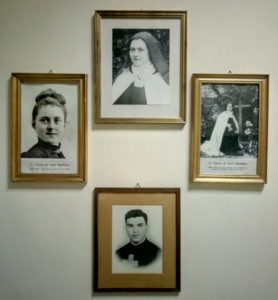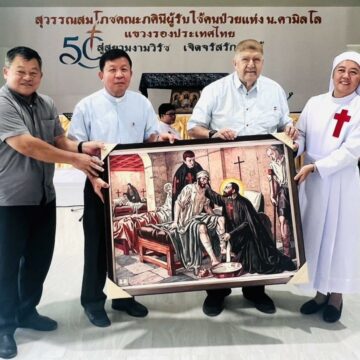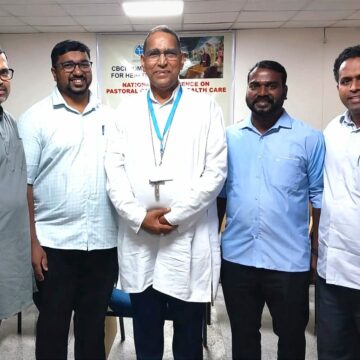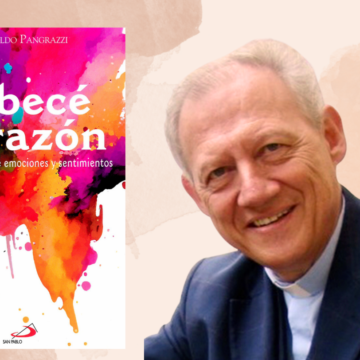 From ‘Una vita donata’ (‘A Given Life’) by F. Ruffini
From ‘Una vita donata’ (‘A Given Life’) by F. Ruffini
One of the intermediate models that guided his journey towards the Lord was St. Therese of the Child Jesus and the Holy Face. Her ‘little way’ became the code of behaviour of his life. In a letter to his mother, who was worried about who knows what kind of penance imposed on him by religious life, Nicolino, in order to reassure her about the normality and the simplicity of his daily life, wrote as follows: ‘St. Therese of the Child Jesus, a French Carmelite sister, did not do anything special during her life, nothing that was extraordinary, she just did what she had to do; at the age of twenty-four she died of tuberculosis and became a saint. Mummy, she certainly died of tuberculosis but she certainly did not catch it from too many penances because she did nothing to excess; her health was not ruined, as might be thought, by penances, and yet today she is a saint. You know, Mummy, I often speak to you about St. Therese of the Child Jesus because I am very devoted to this saint. When something is not going well, I tell ‘Sister Therese’, as I call her, about it and she takes care of it and it goes away. When I have saved up enough money I buy some books by St. Therese; I already have a large number’.
He obtained everything that had been published on St. Therese, asking the convent of Lisieux for the latest publications. He had a good command of French and he set out to translate her poems.
In the memoir that Father Fernando wrote for me we can find the following passage: ‘He had obtained not only the autobiography ‘The History of a Soul’ of St. Therese of the Child Jesus, but also ‘The True Face of St. Therese’ so that he could carry all the photographs of her that had not been published up to that point to as to see her and then study her. I remember very well how much he took pleasure in photographing the small pictures of St. Therese, putting on the front of his camera a large telescope as a lens and lighting up the photographs with a table lamp. He in this way also tried to obtain from those photographs in a small format the nuances of the imperceptible expressions of the face of the saint in various moments and poses. There were also the  writings of Pauline, the Sister and Mother Superior of Therese’.
writings of Pauline, the Sister and Mother Superior of Therese’.
This interest of Nicolino in the little Saint of Lisieux, which grew into a great mystical love, was not appreciated in the seminary except by one of his confreres. A ‘lack of knowledge’ about the experience of God of the young Carmelite saint meant that devotion to her was held to be good for ‘little women’. A judgement in my view, to be kind, which was shallow! Perhaps the kindly character of Nicolino led to a misunderstanding of this great interest of his and his resulting promotion of his ‘model of holiness’ within the seminary.
This can be deduced from what his friend Nicandro wrote: ‘But one day Nicolino, while his was showing me the biography of St. Therese of the Child Jesus that was made up of photographs of her writings, said to me that from that little saint he had very much learnt to do everything with simplicity, especially little things. That morning we spoke a great deal while leafing through that biography, translating some passages together that seemed to us to be especially important. ‘You see her simplicity’, he said to me. And I replied: ‘do you remember when we looked at the stars through a telescope? Looking at this biography you put the telescope in just the right place; I until now had placed it upside down. This is why some of the poses of this saint seemed to me to puerile and insignificant’…He lent that biography to me for two days. When I gave it back to him, he said to me ‘So?’. ‘Thank you’, I said, ‘I now see things more clearly. I will no longer think of you as some confrere who is in love with a little woman saint. She is far from being a little woman! She is not in the least put in the shade by St. Catherine or St. Therese d’Avila!’ He looked at me beaming with happiness.
When thanking his teacher Anna Volpe, who had kindly sent some money with a letter of hers which enabled him to buy ‘Advice and Memories’, which is a book he greatly wanted, he confessed ‘I have great devotion towards this saint because she resembles me a great deal, and from her I can learn how to become perfect’ (6 December 1962).














Camillians on Facebook
Camillians on Twitter
Camillians on Instagram